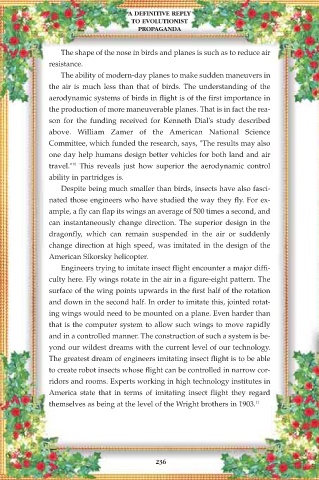Page 238 - A Definitive Reply to Evolutionist Propaganda
P. 238
A DEFINITIVE REPLY
TO EVOLUTIONIST
PROPAGANDA
The shape of the nose in birds and planes is such as to reduce air
resistance.
The ability of modern-day planes to make sudden maneuvers in
the air is much less than that of birds. The understanding of the
aerodynamic systems of birds in flight is of the first importance in
the production of more maneuverable planes. That is in fact the rea-
son for the funding received for Kenneth Dial's study described
above. William Zamer of the American National Science
Committee, which funded the research, says, "The results may also
one day help humans design better vehicles for both land and air
10
travel." This reveals just how superior the aerodynamic control
ability in partridges is.
Despite being much smaller than birds, insects have also fasci-
nated those engineers who have studied the way they fly. For ex-
ample, a fly can flap its wings an average of 500 times a second, and
can instantaneously change direction. The superior design in the
dragonfly, which can remain suspended in the air or suddenly
change direction at high speed, was imitated in the design of the
American Sikorsky helicopter.
Engineers trying to imitate insect flight encounter a major diffi-
culty here. Fly wings rotate in the air in a figure-eight pattern. The
surface of the wing points upwards in the first half of the rotation
and down in the second half. In order to imitate this, jointed rotat-
ing wings would need to be mounted on a plane. Even harder than
that is the computer system to allow such wings to move rapidly
and in a controlled manner. The construction of such a system is be-
yond our wildest dreams with the current level of our technology.
The greatest dream of engineers imitating insect flight is to be able
to create robot insects whose flight can be controlled in narrow cor-
ridors and rooms. Experts working in high technology institutes in
America state that in terms of imitating insect flight they regard
themselves as being at the level of the Wright brothers in 1903. 11
236

